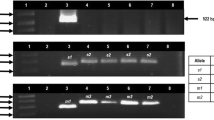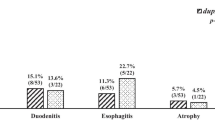Abstract
In addition to the already known cagA gene, novel genetic markers have been associated with Helicobacter pylori (H. pylori) virulence: the dupA and vacAi genes. These genes might play an important role as specific markers to determine the clinical outcome of the disease, especially the vacAi gene, which has been expected to be a good marker of severe pathologies like gastric adenocarcinoma. In the present study, the association of cagA, dupA, and vacAi genes with gastroduodenal pathologies in Chilean patients was studied. One hundred and thirty-two patients positive for H. pylori were divided into two groups—non-severe and severe gastric pathologies—and investigated for the presence of cagA, dupA, and vacAi H. pylori virulence genes by PCR. The cagA gene was detected in 20/132 patients (15.2%), the vacAi1 gene was detected in 54/132 patients (40.9%), the vacAi2 gene was detected in 26/132 patients (19.7%), and the dupA gene was detected in 50/132 (37.9%) patients. Logistic regression model analysis showed that the vacAi1 isoform gene in the infected strains and the severity of the diseases outcome were highly associated, causing severe gastric damage that may lead to gastric cancer (p < 0.0001; OR = 8.75; 95% CI 3.54–21.64). Conversely, cagA (p = 0.3507; OR = 1.62; 95% CI 0.59–4.45) and vacAi2 (p = 0.0114; OR = 3.09; 95% CI 1.26–7.60) genes were not associated with damage, while the dupA gene was associated significantly with non-severe clinical outcome (p = 0.0032; OR = 0.25; 95% CI 0.09–0.65). In addition, dupA gene exerts protection against severe gastric pathologies induced by vacAi1 by delaying the outcome of the disease by approximately 20 years.




Similar content being viewed by others
References
Amjad N, Osman HA, Razak N, Kassian J, Din J, Abdullah NB (2010) Clinical significance of Helicobacter pylori cagA and iceA genotype status. World J Gastroenterol 16:4443–4447
Arachchi HS, Kalra V, Lal B, Bhatia V, Baba CS, Chakravarthy S, Rohatgi S, Sarma PM, Mishra V, Das B, Ahuja V (2011) Prevalence of duodenal ulcer promoting gene (dupA) of Helicobacter pylori in patients with duodenal ulcer in North Indian population. Helicobacter 12:591–597
Chung C, Olivares A, Torres E, Yilmaz O, Cohen H, Perez-Perez G (2010) Diversity of vacA intermediate region among Helicobacter pylori strains from several regions of the world. J Clin Microbiol 48:690–696
Ferreccio C, Rollan A, Harris PR, Serrano C, Gederlini A, Margozzini P, Gonzalez C, Aguilera X, Venegas A, Jara A (2007) Gastric cancer is related to early Helicobacter pylori infection in a high-prevalence country. Cancer Epidemiol Biomark Prev 16:662–667
Gomes LI, Rocha GA, Rocha AM, Soares TF, Oliveira CA, Bittencourt PF, Queiroz DM (2008) Lack of association between Helicobacter pylori infection with dupA-positive strains and gastroduodenal diseases in Brazilian patients. Int J Med Microbiol 20:223–230
Hussein NR, Mohammadi M, Talebkhan Y, Doraghi M, Letley DP, Muhammad MK, Argent RH, Atherton JC (2008) Differences in virulence markers between Helicobacter pylori strains from Iraq and those from Iran: potential importance of regional differences in H. pylori-associated disease. J Clin Microbiol 46:1774–1779
Hussein NR, Argent RH, Marx CK, Patel SP, Robinson K, Atherton JC (2010) Helicobacter pylori dupA is polymorphic, and its active form induces proinflammatory cytokine secretion by mononuclear cells. J Infect Dis 202:261–269
Imagawa S, Ito M, Yoshihara M, Eguchi H, Tanaka S, Chayama K (2010) Helicobacter pylori dupA and gastric acid secretion are negatively associated with gastric cancer development. J Med Microbiol 59:1484–1489
Khodaii Z, Ghaderian SM, Akbarzadeh-Najar R, Nejati H, Tabatabaei Panah AS (2011) CagA and vacA status and influence of Helicobacter pylori infection on serum oxidative DNA damage in Iranian patients with peptic ulcer disease. Ir J Med Sci 180:155–161
Lu H, Hsu PI, Graham DY, Yamaoka Y (2005) Duodenal ulcer promoting gene of Helicobacter pylori. Gastroenterol 128:833–848
Martinez A, Gonzalez C, Kawaguchi F, Montoya R, Corvalan A, Madariaga J, Roa J, García A, Salgado F, Solar H, Palma M (2001) Helicobacter pylori: cagA analysis and vacA genotyping in Chile. Detection of a s2/m1 strain. Rev Med Chil 129:1147–1153
Moura SB, Costa RF, Anacleto C, Rocha GA, Rocha AM, Queiroz DM (2012) Single nucleotide polymorphisms of Helicobacter pylori dupA that lead to premature stop codons. Helicobacter 17:176–180
Nguyen LT, Uchida T, Tsukamoto Y, Kuroda A, Okimoto T, Kodama M, Murakami K, Fujioka T, Moriyama M (2010) Helicobacter pylori dupA gene is not associated with clinical outcomes in the Japanese population. Clin Microbiol Infect 16:1264–1269
O’Ryan ML, Lucero Y, Rabello M, Mamani N, Salinas AM, Peña A, Torres-Torreti JP, Mejías A, Ramilo O, Suarez N, Reynolds HE, Orellana A, Lagomarcino AJ (2015) Persistent and transient Helicobacter pylori infections in early childhood. Clin Infect Dis 61:211–218
Panayotopoulou EG, Sgouras DN, Papadakos KS, Kalliopi P, Sébastien B, Spyros M, Gerassimos M, George P, Andreas M, Athanasios A (2010) CagA and VacA polymorphisms are associated with distinct pathological features in the Helicobacter pylori infected adults with peptic ulcer and non-peptic ulcer disease. J Clin Microbiol 48:2237–2239
Porras C, Nodora J, Ferreccio C, Jimenez S, Dominguez RL, Cook P, Anderson G, Morgan DR, Baker LH, Greenberg ER, Herrero R (2013) Epidemiology of Helicobacter pylori infection in six Latin American countries (SWOG Trial S0701). Cancer Causes Control 24:209–215
Queiroz DM, Rocha GA, Rocha AM, Moura SB, Saraiva IE, Gomes LI, Soares TF, Melo FF, Cabral MM, Oliveira CA (2011) DupA polymorphisms and risk of Helicobacter pylori-associated diseases. Int J Med Microbiol 301:225–228
Rhead J, Letley DP, Marjan-Mohammadi M, Hussein N, Mohagheghi MA, Eshagh Hosseini M, Atherton JC (2007) A new Helicobacter pylori vacuolating cytotoxin determinant, the intermediate region, is associated with gastric cancer. Gastroenterol 33:926–936
Sachs G, Scott DR (2012) Helicobacter pylori: eradication or preservation. F1000 Med Rep 4:1–5
Santibáñez M, Aguirre E, Belda S, Aragones N, Saez J, Juan Carlos Rodríguez JC, Galiana A, Sola-Vera J, Ruiz-García M, Paz-Zulueta M, Sarabia-Lavín R, Brotons A, López-Girona E, Pérez E, Sillero C, Royo G (2015) Relationship between tobacco, cagA and vacAi1 virulence factors and bacterial load in patients infected by Helicobacter pylori. PLoS One 10:1–8
Sokic-Milutinovic A, Alempijevic T, Milosavljevic T (2015) Role of Helicobacter pylori infection in gastric carcinogenesis: current knowledge and future directions. World J Gastroenterol 21:11654–11672
Van Doorn LJ, Figueiredo C, Sanna R, Plaisier A, Schneeberger P, De Boer W, Quint W (1998) Clinical relevance of the cagA, vacA, and iceA status of Helicobacter pylori. Gastroenterology 115:58–66
Vassallo JA, Barrios E (2008) Actualización ponderada de los factores de riesgo del cáncer. Comisión Honoraria de Lucha Contra el Cáncer, Montevideo, pp 9–119
Vega AE, Cortiñas TI, Puig ON, Silva HJ (2010) Molecular characterization and susceptibility testing of Helicobacter pylori strains isolated in western Argentina. Int J Infect Dis 14S:e85–e92
Yamaoka Y (2009) Helicobacter pylori typing as a tool for tracking human migration. Clin Microbiol Infect 15:829–834
Yamaoka Y (2012) Pathogenesis of Helicobacter pylori-related gastroduodenal diseases from molecular epidemiological studies. Gastroenterol Res Pract 37:1–9
Yordanov D, Boyanova L, Markovska R, Gergova G, Mitov I (2012) Significance of Helicobacter pylori vacA intermediate region genotyping-a Bulgarian study. Diagn Microbiol Infect Dis 74:253–257
Zhang KL, Sun Y, Li Y, Liu M, Qu B, Cui SH, Kong QY, Chen XY, Li H, Liu J (2008) Increased frequency of CpG island methylator phenotype and CDH1 methylation in a gastric cancer high-risk region of China. Transl Oncol 1:28–35
Zhang RG, Duan GC, Fan QT, Chen SY (2016) Role of Helicobacter pylori infection in pathogenesis of gastric carcinoma. World J Gastrointest Pathophysiol 7:97–107
Acknowledgements
This paper was supported by Fondef D03i1105.
Author information
Authors and Affiliations
Corresponding author
Ethics declarations
The Ethic Committee of the Clinical Hospital “Guillermo Grant Benavente” approved the study protocol (code # 08-03-03). All patients were of first attendance to the hospital and non-previous clinical records were registered. The patients signed an informed consent form prior to acceptance in the study and were additionally asked about antibiotic consumption, previous gastric diseases, smoke inhalation, or alcoholic beverage consumption in order to exclude these factors.
Rights and permissions
About this article
Cite this article
Paredes-Osses, E., Sáez, K., Sanhueza, E. et al. Association between cagA, vacAi, and dupA genes of Helicobacter pylori and gastroduodenal pathologies in Chilean patients. Folia Microbiol 62, 437–444 (2017). https://doi.org/10.1007/s12223-017-0514-y
Received:
Accepted:
Published:
Issue Date:
DOI: https://doi.org/10.1007/s12223-017-0514-y




